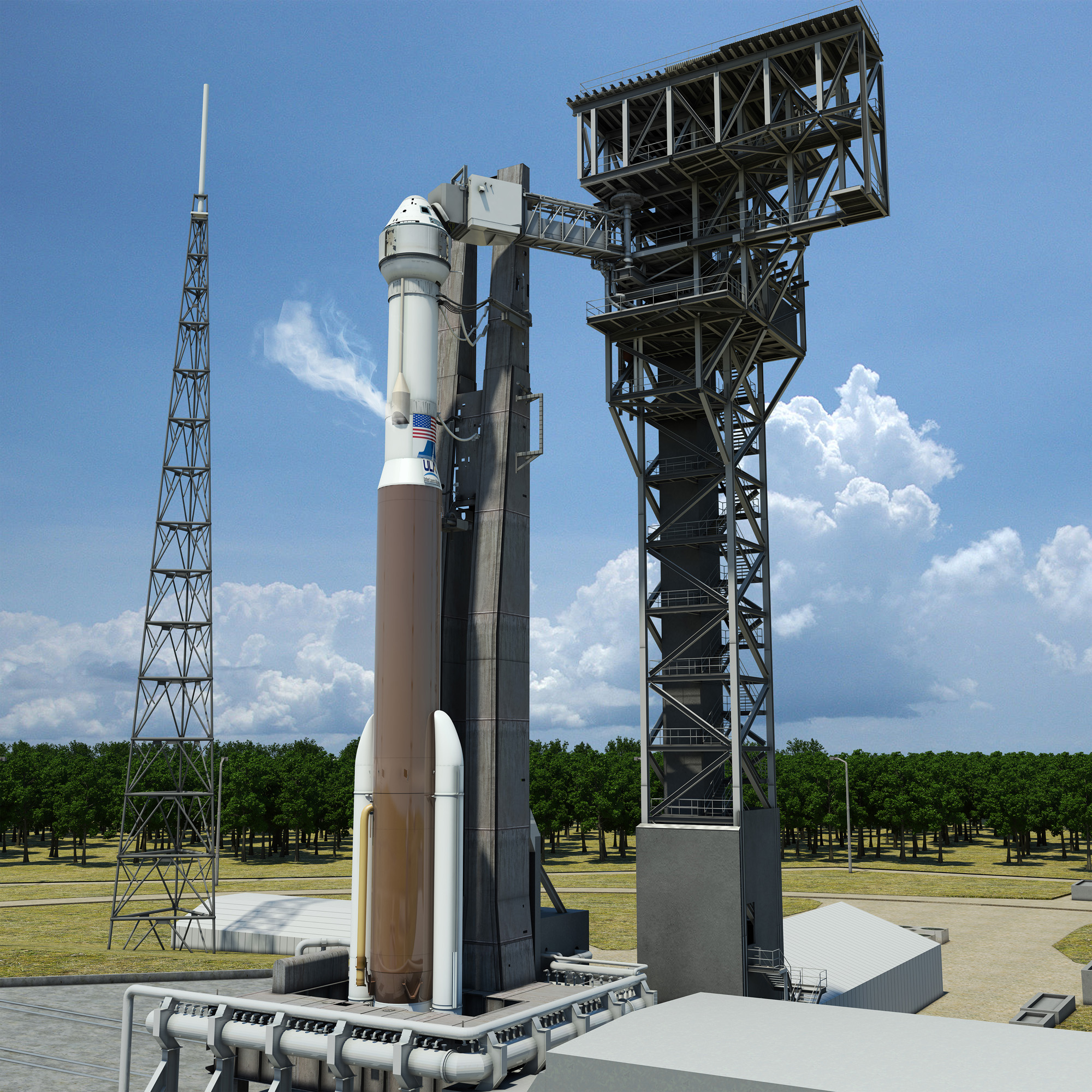
Artist’s concept of Boeing’s CST-100 space taxi ready for liftoff atop a man rated ULA Atlas-V rocket showing new crew access tower and arm at Space Launch Complex 41, Cape Canaveral Air Force Station, Fl. Credit: ULA
CAPE CANAVERAL AIR FORCE STATION, FL – America’s human path back to space from U.S. soil starts rising rapidly this summer, as construction of the new crew access tower for ULA’s Atlas V “space taxi” rocket moves into high gear at Cape Canaveral, Fla., while the newly human-rated booster launching from it and carrying Boeing’s CST-100 crew capsule to orbit and the International Space Station (ISS) simultaneously starts assembly at ULA’s rocket factory in Decatur, Ala.
The entirely new 200-foot-tall “tower structure goes up rather quickly this summer [2015] at launch pad 41,” Howard Biegler, ULA’s Human Launch Services Lead, told AmericaSpace during an exclusive interview detailing pad modifications and construction at the Atlas V Launch Complex 41 facility at Cape Canaveral Air Force Station, Fla.
“The entire tower will be erected over six weeks in the summer. It’s like an erector set!”
Space Launch Complex-41 (SLC-41) is being significantly modified to accommodate astronaut launches now that NASA has officially selected the two firms—Boeing and SpaceX—to build the world’s first privately developed crewed spaceships for blastoff to the ISS.
“Construction by the Hensel Phelps team effectively started in January 2015 and we are in the process of making this a reality,” Biegler said.
Meanwhile, ULA has begun fabricating long lead time parts of the pair of 20-story-tall Atlas V rockets that are to launch the CST-100 spacecraft on its first uncrewed and crewed test flights in 2017 from the newly upgraded pad 41.
Those two Atlas V rockets are dubbed with unique, distinguishing tail numbers—AV-073 and AV-080—and will be the first of that family to be certified by ULA and NASA to launch humans to the ISS.
Chris Ferguson, commander of NASA’s final shuttle flight and now director of Boeing’s CST-100 Crew and Mission Operations, recently toured the 1.6 million square foot Decatur facility and met with the engineering teams manufacturing the Atlas Vs for the historic 2017 liftoffs. Read the exclusive interview with Ferguson here and here.
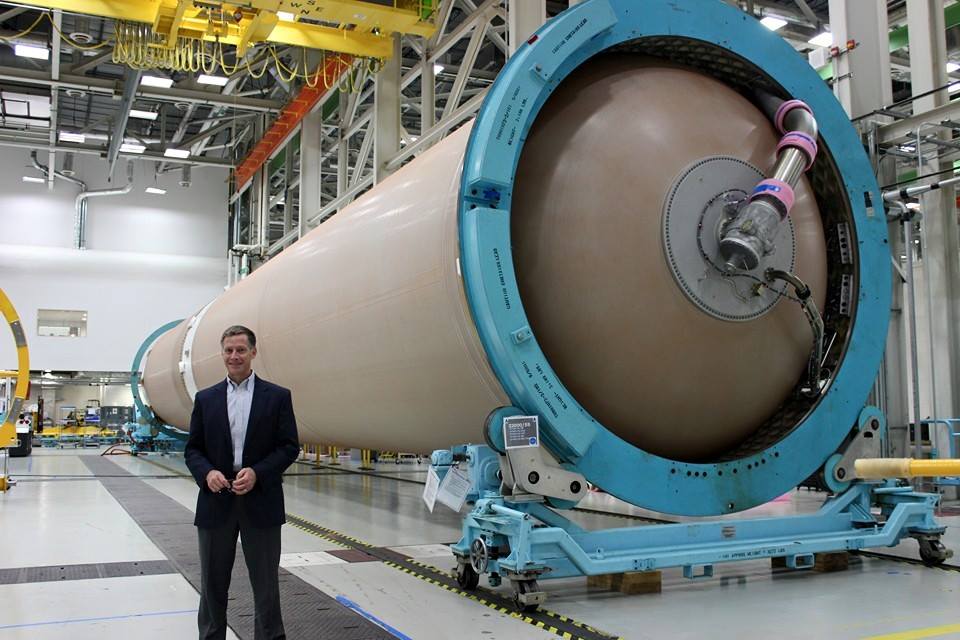
To accomplish all that, the Cape Canaveral skyline will change rapidly and dramatically, starting in July with visibly tangible progress toward restoring America’s manned access to space that was totally lost following the forced retirement of the shuttles after touchdown of Ferguson’s crew on the STS-135 mission in 2011 at the Kennedy Space Center’s shuttle landing facility (SLF).
On Sept. 16, 2014, NASA Administrator Charles Bolden announced at KSC that Boeing and SpaceX were both awarded contracts under NASA’s Commercial Crew Transportation Capability (CCtCap) program and Launch America initiative to finalize the design and develop their CST-100 and Dragon V2 crewed spaceships respectively, aimed at returning human spaceflight launches to the United States by 2017 and end our sole source reliance on Russia.
The metal latticework for ULA’s 20-story-high Atlas tower was designed to be modular for ease of construction, and literally ascends skyward as crews stack the structural steel components atop one another piece by piece with cranes.
Since pad 41 is one of the most active launch pads in the world, and ULA can’t afford to halt launches on its packed manifest, construction of the crew access tower has been carefully planned to take place in between the lucrative launches for a variety of clients, including civilian and military entities from the government and commercial customers.
“The tower is comprised of 7 major tier segments,” Biegler told AmericaSpace. “Each is about 20 foot square and 28 feet tall.’’
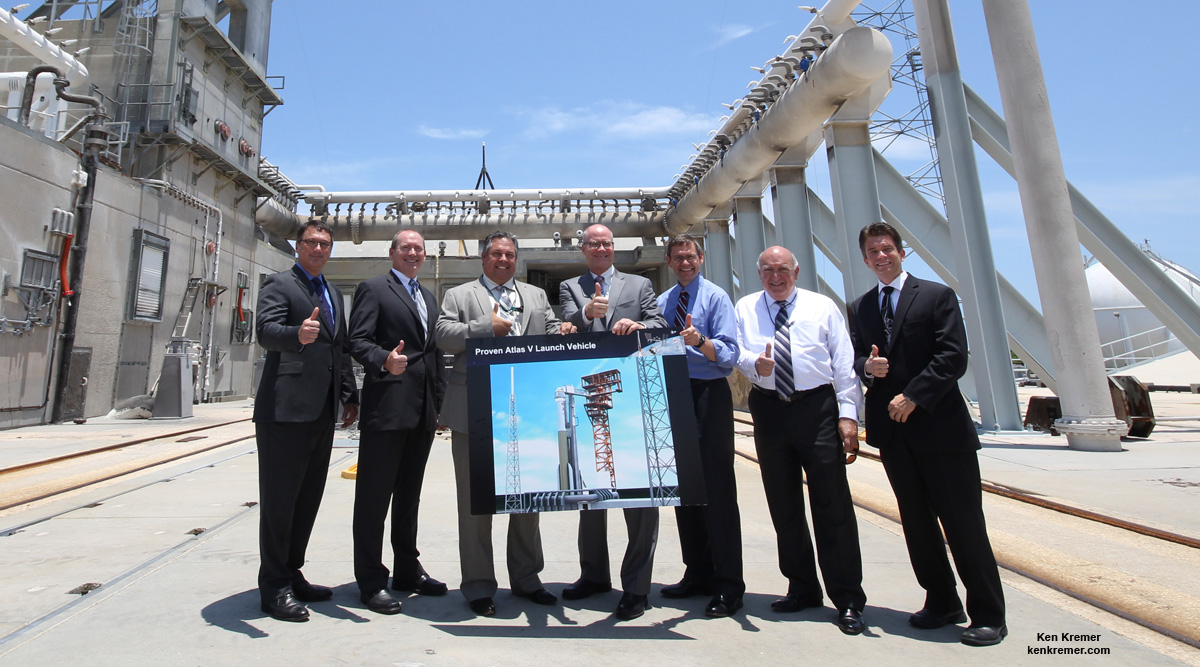
The ceremonial groundbreaking ceremony to start tower construction was held Feb. 20, 2015.
The crew access tower is the first of its kind to be built in decades on the Florida Space coast and will enable astronauts and support personnel access to a rocket awaiting blastoff to space.
“The first truss segment will be transported out to the pad and installed in the July time frame,” Biegler elaborated. “That will be an above ground segment.”
“The rest happens quick over the course of a six or seven week period. So the remaining pieces of the tower goes up rather quickly.”
“We plan to have the entire tower erected over six weeks in the summer. It’s like an erector set! Its built off site in its entirety. Then it’s just a matter of bolting the pieces together.”
“It’s the longest work window we have this summer. So, barring unforeseen delays, the plan is for the major structure to be completed in one mod window, this summer,” Biegler told AmericaSpace.
Piece parts for the truss segments are built off site and then trucked to a construction lot on the Cape by the ASOC, or Atlas Space Operations Center.
“We will start mobilizing the iron workers to start fabrication of the tower pieces in late April to mid May,” Beigler stated.
Then the parts undergo final assembly into the individual major tier segments of the crew access tower by the ASOC.
“The first complete tier segment will be done soon thereafter.”
The segments will then be trucked to pad 41 and stacked this summer.
“The goal is to have the major tower structure built and complete over the summer.”
But before any tower assembly can take place, an area of concrete on the pad surface structure had to be demolished and hammered away. The work started right around the launch of MUOS-3 in January, and the site is now being excavated down to a depth of some 13 feet.
“Currently at the pad we have already drilled and poured ten 42-inch-diameter piers, during what was known as the 2nd defined mod [construction] window. They are each 105 feet deep,” Biegler explained. “We are currently in our 3rd mod window.”
“Altogether there are 15 mod, or work windows which are defined periods of time when there is no launch vehicle at the pad.”
“Leading up to the last launch, which was MMS [Magnetospheric Multiscale mission for NASA on March 12], we did some concrete demolition, enough to accommodate the ten piers. We also installed the sheet piles [like a retainer wall] on the north and south sides and pond liner to catch wastewater from launches.”
“Construction was demobilized briefly to accommodate the MMS launch.”
Work in this work window will continue until the next Atlas launch in May, “starting with a mass excavation down to about 13.5 feet. The old MST tracks from the Titan Centaur days will also be cut out and removed. Then the dowels will be installed to secure the crew access tower.”
“Right now we are working no issues with the construction effort. We are actually a little bit ahead of schedule, despite the delays in NASA awarding the commercial crew contracts from the summer until September and then the SNC protest.”
“We will enter our fourth ‘mod window’ after the Atlas launch in May.”
After the tower is erected comes all the remaining steel, electrical, plumbing, staircase, structure, testing, and calibration work over the next year.
“After the tower buildup comes the extensive work to outfit the tower with over 400 pieces of outboard steel that have to be installed. That takes much longer and will be done over the course of the next two mod windows,” Biegler said.
“In parallel with that is the arm buildup.”
“The completely integrated and tested crew access arm and walkway should be brought out to the launch site around May 2016 roughly.”
“The arm will be fully tested with the torque tube to make sure it meets all the line requirements.”
After the crew tower is installed, the look of the SLC-41 will change drastically from the current “clean pad” design, which features only the reinforced concrete hard stand and four lightning towers.
Only very minor changes are planned for the Vertical Integration Facility, a building about 1,800 feet to the south where the Atlas V rocket is assembled.
“The plan is to finish all the site construction, testing [and certification] done by September 2016,” Biegler explained.
The arm installation, plumbing, and hydraulic drive system installation will take about a month, followed by all the validation testing by the contractor.
“Then it’s turned over to my team to do all the acceptance testing,” Biegler stated.
“The work will wrap up in September 2016.”
Indeed, if the funding was available to get Boeing’s space taxi capsule ready sooner, the first crew could launch on the first CST-100 test flight as soon as the tower is declared operational in September 2016.
“We could launch after completion in September 2016. Earlier in the [CCP] program we had to plan for launches as early as December 2016. And we have never slipped off of our September 2016 completion date.”
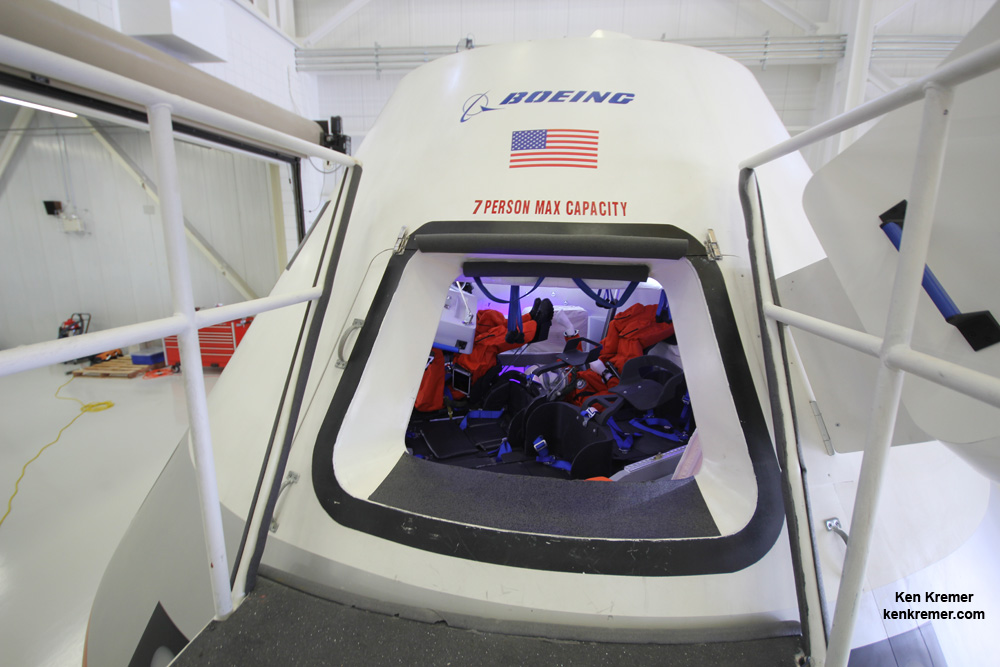
“But the team has been instructed that we don’t want to do anything that presents risk!”
The currently planned launch date for the first unmanned CST-100 test flight is roughly around February 2017 and subject to manifest changes.
The actual launch date hinges on the NASA budgets approved by the Obama Administration and U.S. Congress.
Since the retirement of the shuttle, American astronauts have been totally dependent on the Russian Soyuz capsule for rides to the ISS and back, at a cost now exceeding $70 million per seat.
NASA Administrator Charles Bolden has said that he doesn’t want to write any more checks to Roscosmos and that any cut in CCP funding from the Obama Administration’s FY 2016 budget request will delay the program and first launch.
See video below detailing construction of ULA’s commercial crew access tower at pad 41:
Video caption: New Commercial Crew Access Tower Going Up. Boeing and United Launch Alliance will add to the Space Coast skyline with the 200-foot-tall tower. It will be assembled over 18 months at Space Launch Complex 41 and is designed to meet the needs of test pilots, astronauts and support personnel who will access Boeing’s CST-100 before it launches atop an Atlas V. Credit: NASA
No humans have ever launched to space from SLC-41. And it’s been over 50 years since astronauts launched on an Atlas rocket. Among them was Mercury astronaut John Glenn, the first American to orbit the Earth, back on Feb. 20, 1962.
For further details, be sure to read the prior articles outlining the CST-100 in an exclusive interview with Chris Ferguson, commander of NASA’s final shuttle flight and now director of Boeing’s Crew and Mission Operations, here and here.
Meanwhile, NASA simultaneously continues pushing forward with its deep space pillar of human spaceflight involving Orion and SLS. Read the latest updates here and here and here.
Stay tuned here for continuing updates.
Want to keep up-to-date with all things space? Be sure to “Like” AmericaSpace on Facebook and follow us on Twitter: @AmericaSpace
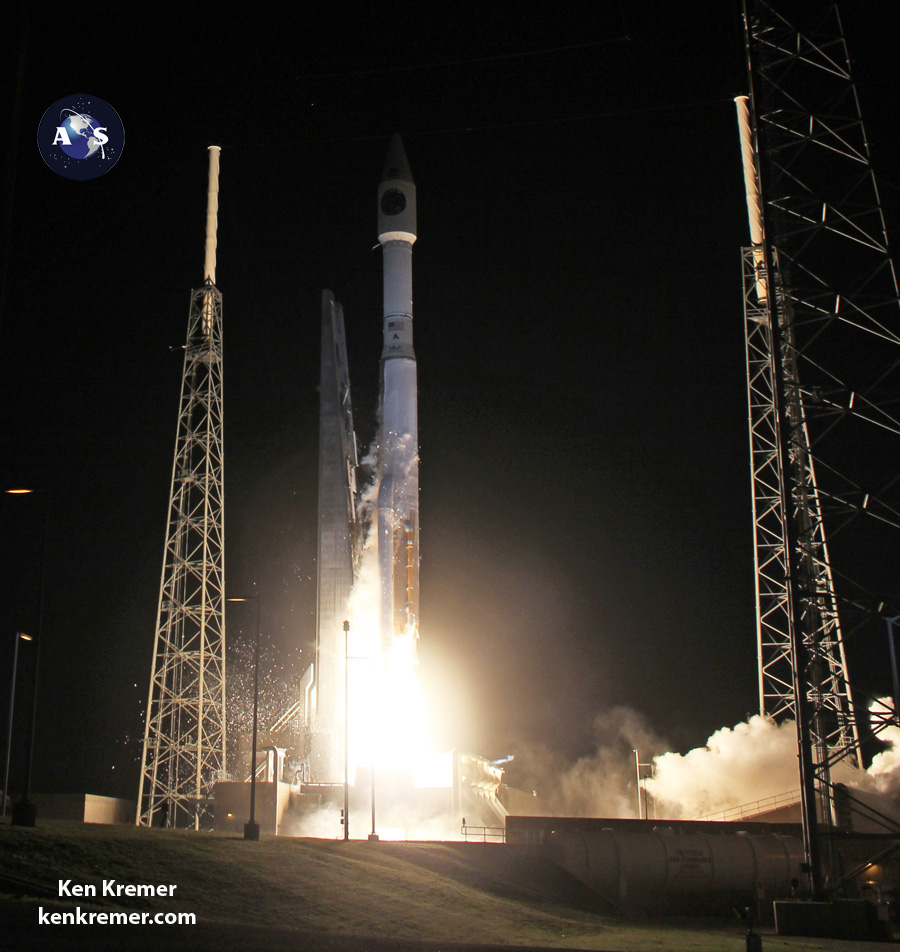
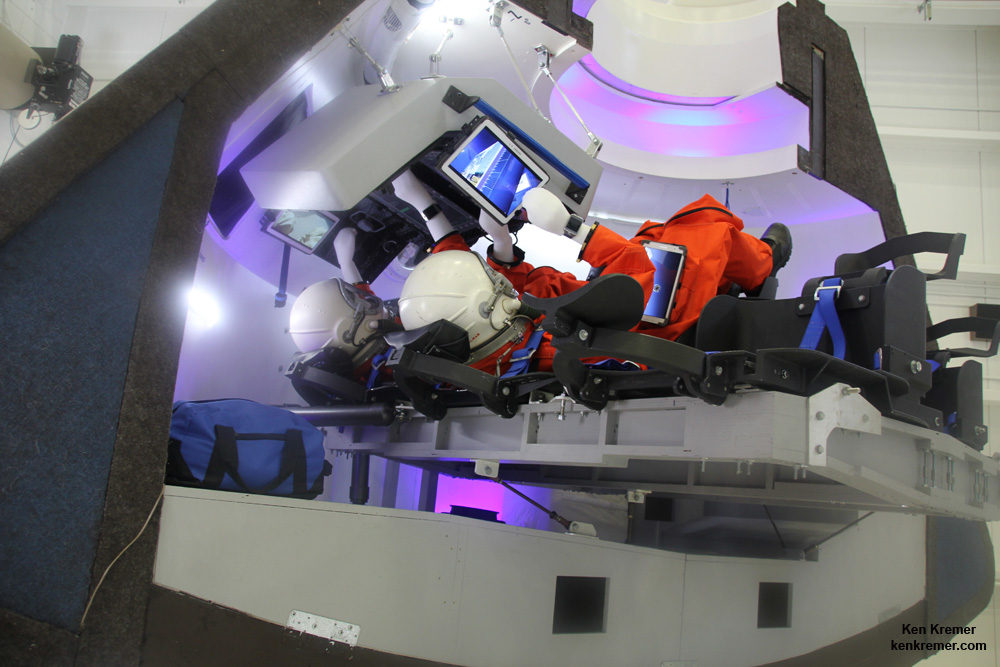




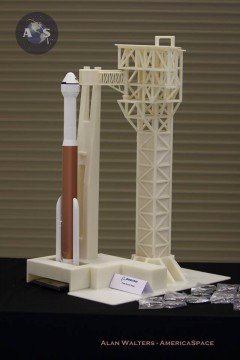
Fairly in-depth article considering it is only about conversion of a pad to add a crew access tower. Most people have no idea of this segment of the road to space for humans. The title suggests the article would have covered both Boeing/ULA preparations and SpaceX (Pad 39A). Pad 39A is probably the bigger job since it entails converting and/or working around pre-existing Shuttle infrastructure. The road to put humans back in to space from US soil, however, is best told by discussing the efforts of both companies. You might even go so far as to parallel the preparations planned for launching SLS when manned flights begin with it (Someday?).
Why people still make use of to read news papers when in this technological world everything is existing on net?|